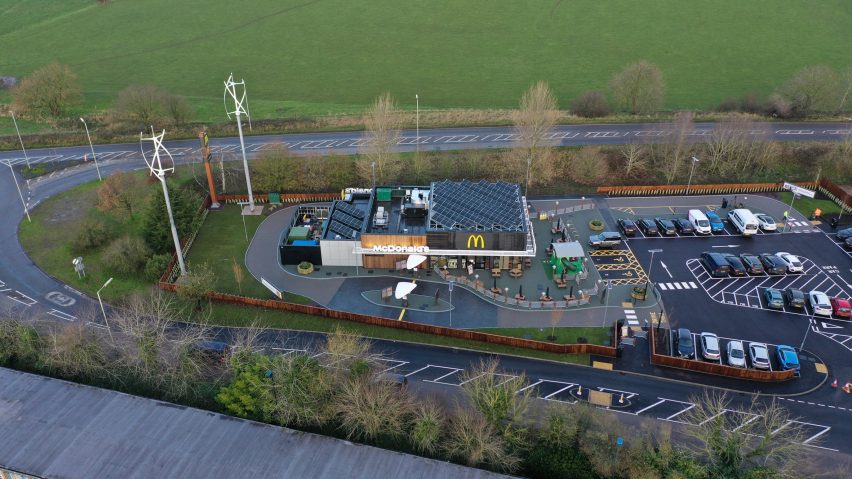Fast-food chain McDonald's has opened what it claims is the UK's first net-zero carbon restaurant building.
Built using natural or recycled materials and powered by a combination of wind turbines and solar panels, the restaurant, in Market Drayton, Shropshire, was designed to meet net-zero standards in both its construction and everyday operation.
However, McDonald's confirmed to Dezeen that consumption-based emissions associated with its beef-heavy menu have not been taken into account – meaning that the restaurant overall is not net-zero in the strictest sense.
For a building to be net-zero it must remove as much carbon dioxide from the atmosphere as it emits throughout its lifespan, both in the form of embodied carbon and operational carbon associated with construction, occupation and eventual demolition.
McDonald's said the Market Drayton eatery is the first in the country which fits into the UK Green Building Council's (UKGBC) net-zero carbon buildings framework.
It plans to use the design as a "blueprint" for McDonald's new builds around the UK from 2022, with some of the sustainable measures already being implemented at other outlets.
The building was designed by Hertfordshire studio Scurr Architects, while Manchester-based AEW Architects handled site design.
"At McDonald's, we believe that our food needs to be served in restaurants that are sustainable for the future," said Beth Hart, McDonald's vice president of supply chain and brand trust.
"Market Drayton is a big step towards making that a reality, enabling us to test and put into practice what a net-zero emissions building, both in build and use, really looks like."
The restaurant's walls are insulated with wool from British sheep instead of man-made materials, while the cladding is crafted from recycled IT equipment and white household goods.
Signs are made from used McDonald's coffee beans, in what the chain described as an example of its action to introduce "circular waste solutions".
In the car park, more than 1,000 kerbstones were made from 182 recycled plastic bottles each, which McDonald's said reduced carbon emissions by 25 kilograms per kerb compared to conventional concrete examples.
Designed to have "McDonald's look and feel"
The drive-thru lane was constructed from recycled tyres, producing less greenhouse gas than tarmac and reducing the amount of water washing down the drain by being more absorbent.
Power is provided by two on-site wind turbines and 92 square metres of solar panels, together producing 60,000-kilowatt-hours of energy per year.
Local school children have also designed a biodiversity garden and nature trail for behind the restaurant.
Despite the green innovations, the Big Mac maker said the restaurant "has been deliberately designed to retain the familiar McDonald's look and feel", in order to make it easier to replicate on other sites.
In response to a question from Dezeen about whether it used carbon offsetting for the Market Drayton restaurant, which is required in most cases to achieve net-zero status for buildings, McDonald's said that where it could not decarbonise beyond construction impacts, energy use and producing renewable power, it neutralised "any remaining emissions with high-quality carbon removal projects".
McDonald's has set itself a target to make all 1,400 of its restaurants and offices in the UK meet net-zero emissions standards by 2030, and for its entire UK and Ireland business, including food, to follow suit by 2040.
Its next commitment is for all furniture in its new and refurbished restaurants to be made from recycled or certified materials and designed to be recycled or reused by 2023.
By 2025, it has pledged to have a "market-leading vegan, plant-based food and drinks offering".
"The challenge of decarbonising the construction industry is a complex one, but McDonald's commitment to building the first restaurant in the UK in line with UKGBC's net-zero carbon buildings framework is a critical first step," said Simon McWhirter, director of communications, policy and places at UKGBC.
"We welcome the ambition to achieve net-zero emissions for all McDonald's restaurants and offices by 2030."
The photography is by Anthony Devlin and Richard McCarthy/PA Wire.

